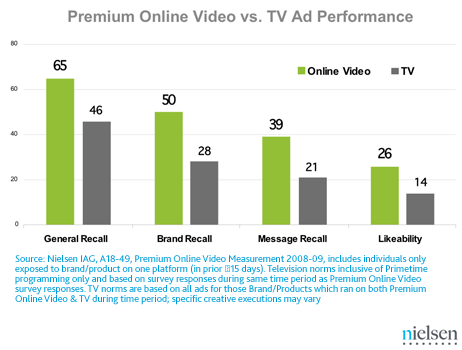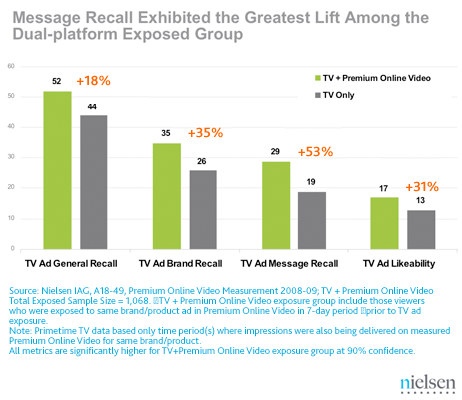With most U.S. homes connected to broadband, the viewing of online video has never been easier. Whether watching a short clip on YouTube or an entire TV program, almost three-quarters (72%) of Internet users view videos online — amounting to 144 million people. To marketers, this presents a huge – and largely untapped – audience to reach. And while online advertising fell overall in 2009, ad spend on online videos grew 41%.
In a recent presentation at the Advertising Research Foundation’s annual RE: Think conference, Dave Kaplan, Senior Vice President, Product Leadership at Nielsen IAG, and Beth Uyenco, Director of Global Research at Microsoft, discussed the ins and outs of online advertising and how to effectively reach video viewers. Evaluating 238 brands encompassing 412 products in 951 ad executions in streaming full-episode TV programs, Nielsen IAG used the key brand impact metrics of ad recall, brand recall, message recall and likeability to determine the effectiveness of ads. More than 14,000 surveys were conducted.
The patterns they uncovered were consistent: video ads run during online full-episode TV programs yield deeper brand impact than corresponding on-air TV ads, with the difference most pronounced among younger viewers age 13-34.

What accounts for this variation in impact between online video and traditional TV? Data shows that web video viewers are more engaged and attentive to the programs they are watching, which is likely a function of the viewing environment and the oft-required active mouse-clicking to initiate nd continue content. Online video is also still a relative novelty compared to traditional forms of media. Further, and most significantly, reduced ad clutter and the inability to easily skip ads are considerable recall-enhancing factors.
While creating a unique ad specifically for use in online video may be desirable, advertisers might want to consider that TV ads repurposed for online full episodes actually generated the top results. It may be that the TV executions possess higher production values, or that online full episode viewers still prefer the absorptive and passive nature of traditional-style TV spots.
“Advertisers might be able to save money by utilizing those ads already in the hopper. Even when controlling for exposure, we see that repurposed TV spots resonate quite well in the streaming full-episode environment,” said Kaplan.
| In-Stream Ad Performance by Creative Type | ||||
|---|---|---|---|---|
| Creative Type | General Recall | Brand Linkage | Message Linkage | Likeability Linkage |
| Repurposed TV Ads | 66% | 76% | 80% | 55% |
| Web Original Video Ads | 58% | 72% | 72% | 48% |
| Flash Animation/Interactive | 47% | 78% | 68% | 46% |
| Source: The Nielsen Company |
But the results of the study don’t point toward an “either or” approach to advertising dollar allocation, especially given that audience reach and CPMs can vary greatly between linear TV and online streaming TV. Instead, the data suggests the benefits of utilizing both platforms in tandem to achieve advertising objectives.
“It appears that leveraging the large reach of TV in combination with the standalone impact and amplifying effect of online video makes for a successful marketing strategy,” said Kaplan.
Specifically, online video ads help to reinforce and strengthen the impact of a traditional TV campaign. Including online video advertising in the media mix and synchronizing with TV greatly improves all key brand metrics, especially message recall.



